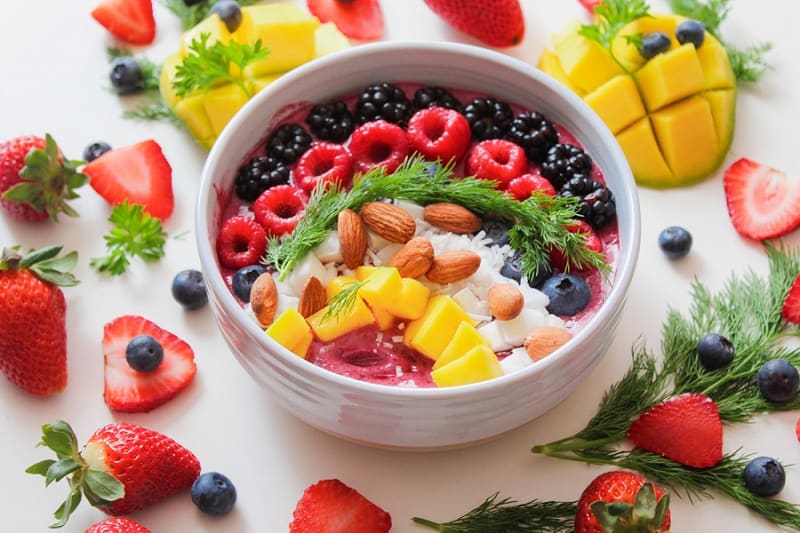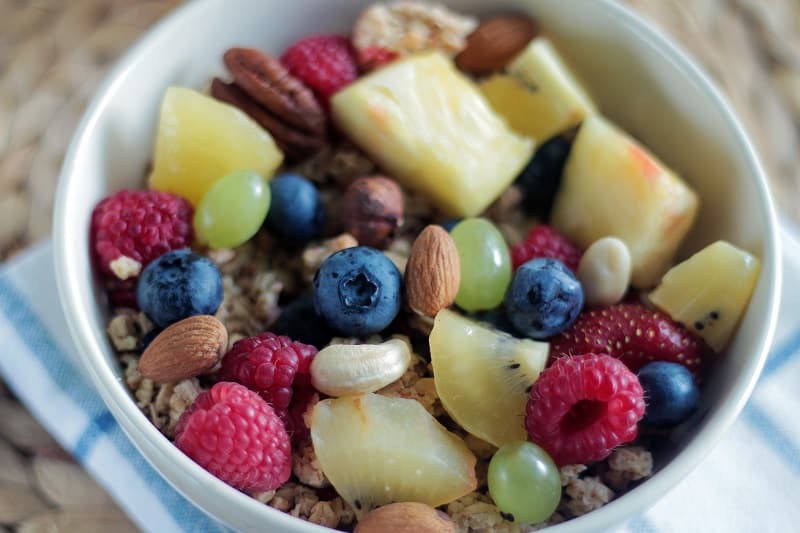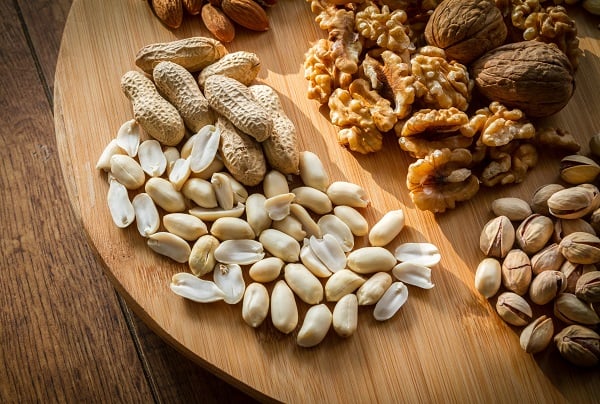There are many debates out there today touting the benefits of a paleo or plant-based diet and which one is right for you. But which one is actually healthier and which is just another fad?
The health benefits of a diet based on whole natural plant foods far exceeds those of a heavy animal-based dietary pattern. A plant-based diet has been proven to extend the quality and length of life, while a paleo diet promotes disease and weight gain, overall.
There are many factors to take into account when determining which of these dietary patterns are right for you. Let’s take a look at some of the pros and cons of each diet and what the research says about the long term impacts of paleo vs plant-based.
What is a plant-based diet?
Most people who identify with this dietary pattern consume what is known as a whole-foods plant-based diet, (WFPB). This would consist of most or all plant foods in they’re most natural state. So, an example of this would be choosing whole grain rice instead of rice pasta, or peanuts instead of peanut butter.
Many people who choose this lifestyle are also vegan, but it is not required. A vegan is someone who consumes zero animal products. The following would be considered foods you would NOT eat on a vegan diet:
- beef
- chicken
- pork
- fish
- shellfish
- eggs
- cheese
- ice cream
- milk
- yogurt
- butter
- honey
A plant-based diet is more easily depicted on a spectrum. On one end you have those who eat all plants and zero animal products, similar to a vegan diet. On the other end, you have those who consume slightly more than half of their calories from plants and the rest from animal products.
Yes, I realize those are two very broad ranges to be considered the same type of diet, but it’s the reality. “Plant-based” technically means you are getting more than 50% of your overall calories from plant foods.
If someone is choosing a plant-based lifestyle for health-related reasons, however, it is wise to consume little or no animal products of any kind while sticking to WHOLE, unrefined plant foods.
So those are the two major characteristics of a plant-based diet:
- The vast majority of calories, (if not all) come from plant sources
- The plants consumed are minimally processed or completely unprocessed
For our purposes, I am going to refer to a plant-based diet as one that holds true to the two characteristics listed above. As it is these two factors that establish the major health benefits of the diet.
Put more simply, a plant-based (PB) diet consists of foods from the following whole food categories:
- Legumes
- Whole grains
- Vegetables
- Fruits
- Nuts
- Seeds
The plant-based, vegan theory

The premise for a PB diet originates from the preponderance of available scientific evidence. The data from epidemiological, experimental, clinical, observational studies, and so forth show a dietary pattern containing high-nutrient, low-calorie plant foods is most consistent with our biological design due to its ability to promote health and reduce disease risk.
The most compelling studies are those comparing different dietary patterns to disease outcomes. Researchers compare those following vegan, vegetarian, lacto-vegetarian, lacto-ovo vegetarian, lacto-ovo pescatarian, and meat-eaters to determine which dietary pattern has the greatest disease risk.
- Vegan refers to those consuming zero animal products
- Vegetarian is a broad term that could refer to anyone on a mostly plant diet, but also some animal products
- Lacto-vegetarian refers to those consuming dairy in addition to a vegetarian diet
- Lacto-ovo vegetarians are those consuming dairy and eggs in addition to a vegetarian diet
- Lacto-ovo pescatarian refers to those consuming fish and plants only
- Meat-eaters refer to those who consume meat, eggs, or dairy several times per day
The results from these comparative studies clearly depict a pattern showing the more animal products that are incorporated into an individual’s diet, the higher their risk increases for all-cause mortality. That means people are more likely to die for any reportable reason due to the harm placed on the body’s cells, tissues, and organ systems caused by eating meat, cheese, eggs, etc.
Conversely, these studies also reveal that when the diet consists of more plants than animal foods, the disease risk decreases. Here is a bulleted list to bring home the significance of this conclusion:
- Vegans showed the least disease risk
- Vegetarians showed a slightly higher risk than the vegans
- Lacto-vegetarians showed a higher disease risk than the vegetarians
- Lacto-ovo vegetarians had an even higher disease risk than the Lacto-vegetarians
- Lacto-ovo pescatarians had a greater disease risk than Lacto-ovo vegetarians
- Meat-eaters or nonvegetarians had the highest disease risk
Ultimately, these studies show that the amount of animal products in the diet is directly linked to the amount of disease expression displayed by the individual. The greater the consumption of animal foods, the greater the disease risk. The lower the consumption of animal foods, the lower the disease risk.
This is also the case for BMI, by the way. The more animal products consumed, the higher the study subject’s BMI. And vice versa for fewer animal products.
A BMI, or body mass index, simply refers to your height to weight ratio. It is an overall measurement of body fat. Excess body fat is, in and of itself, linked to a number of diseases such as obesity, diabetes, heart disease, and cognitive decline.
Why do people consuming animal products have higher BMIs? Because animal foods contain saturated fat, trans-fat, and cholesterol. These are all things that the majority of plant foods do not contain.
Animal foods also cause a greater percentage of body fat because they lack fiber, water, and most vitamins and minerals. Plant foods are the opposite having high fiber, water, and micronutrient (vitamins, minerals, etc.) content.
The following table summarizes the above information:
| Plant Nutrient Composition | Animal nutrient Compostion |
|---|---|
| High fiber | Zero fiber |
| High water content | Zero to minimal water content |
| High micronutrient-density | Low micronutrient-density |
| Low-calorie | High-calorie |
| Zero to low saturated fat | High saturated fat |
| Zero cholesterol | High cholesterol |
| Zero trans-fat | High trans-fat |
Benefits of a plant-based, vegan diet
1. Reduced risk of chronic disease
Eating more plant foods, in general, is associated with gains in health improvement. By incorporating more fruits and veggies into your daily calorie intake you inevitably substitute out less healthy foods to make room for the high-fiber, high nutrient-dense items. So it’s a win-win.
Some specific illnesses shown to improve on a plant-based dietary pattern are:
- diabetes
- cancer
- heart disease
- hypertension
- dementia
- autoimmune disorders
- mental illness
- thyroid disorders
- asthma
- allergies
- skin disorders
- liver and kidney disease
- cataracts
- fertility problems
- chron’s
- lupus
- colitis
- inflammatory bowel disease
- diverticulosis
- osteoarthritis
- multiple sclerosis
This list could literally go on and on, but I think you get the picture. Acquiring a reduced risk of acquiring the majority of the world’s leading causes of death is enough benefit alone to motivate me to stay plant-strong!
2. Reduced risk of weight gain and obesity
We already touched on this benefit to eating plant-based in the Theory section above, but I will elaborate further here to really bring it home.
People following a healthy plant-based, vegan diet have consistently shown to have BMIs below 25. In fact, they tend to have an average BMI between 21 and 23. BMI stands for body mass index. It’s basically your weight to height ratio and is commonly used as a measurement of your body fat.
Anything above a BMI of 25 is considered “overweight”. People consuming a standard Western diet tend to have a BMI well above 25.
In reference to the studies comparing vegans to nonvegetarians and everything in between, the major conclusions to these studies are summed up here:
- The more plants you eat the lower your BMI (body fat).
- The fewer plants you consume the higher your BMI and overall body fat percentage.
3. Improvement in energy and overall feelings of wellness

When you provide your body with the proper fuel needed to carry out its daily metabolic functions you will notice sustained energy throughout the day. Plant foods contain all the necessary nutrients needed for your regular day to day activities, or even for more strenuous activities such as completing triathlons.
The digestive system is necessary for energy, growth, and cell repair, but certain food products require excessive amounts of effort to digest and thus are more draining.
Animal-based protein is especially difficult to digest. More stomach acid secretion, pancreatic enzyme secretion, and bile synthesis are required to breakdown animal protein because they are more acidic. This means more digestive complexity and digestive energy are required.
On the other hand, plant-based protein is much easier to digest and does not put your digestive system through added energy expenditure. Naturally occurring plant foods are also filled with complex carbohydrates which play an important role in energy metabolism. –OneGreenPlanet.Org
4. Improvements in mental health
Recent research shows vegetarians had fewer symptoms of depression, anxiety, stress, and mood disturbance than omnivores. Higher levels of antioxidants in the blood from plant sources have been associated with a significantly lower risk of depression, and lower suicide rates have been tied to higher consumption of fruit, vegetables, nuts, and soy and a lower intake of dairy, meat, and fish.
Animal products such as chicken, beef, and eggs have been shown to produce significant bouts of inflammation in the brain and throughout other areas of the body.
Many plant foods have been shown to reduce symptoms of mental disorders such as depression, social anxiety, ADHD, and bipolar disorder. Some examples of these foods are saffron, green tea, seeds, and turmeric.
Overall, it appears there is an overwhelming amount of evidence revealing the harmful effects animal products have on mental health, while plant foods seem to have preventative and beneficial effects.
For a greater in-depth look at the benefits of a plant-based diet visit my article 12 Top Benefits of a Plant-based, Vegan Diet.
What is a paleo diet?

Unlike a plant-based diet, a paleo diet supports a high consumption of animal foods. Individuals following a paleo-based dietary pattern try to focus their caloric intake on the following:
- meat
- poultry
- fish
- eggs
- vegetables
- fruits
- nuts
- seeds
These folks also refrain from eating these items:
- processed foods
- grains
- legumes
- dairy products
As you can see, there are several similarities between a plant-based and paleo diet. Both focus on eating whole natural foods while refraining from heavily processed items.
The paleo theory
The overall premise behind a paleo diet is that the human diet should resemble that of our preagricultural, paleolithic ancestors who lived between 2.5 million to about 10,000 years ago. Therefore, any dietary inclusion humans have cultivated within the past 10,000 years is considered inconsistent with our natural evolutionary needs.
The foods developed within the past 10,000 years are the major foods abstained from on this diet, such as:
- whole grains
- legumes
- dairy
- processed foods
The diet’s reasoning is that the human body is genetically mismatched to the modern diet that emerged with farming practices — an idea known as the discordance hypothesis.
Paleo folks attempt to mimic the hunter-gatherer approach to a healthy diet. This is a great idea in theory, but it comes with several issues that are completely incapable of being reenacted in our modern-day world.
Preagricultural diets consisted of:
- wild plants
- wild animals
- wild fish
These food items varied tremendously depending on the season, location, available tools, hunting and gathering skills, how many people were involved in the hunting and gathering, etc.
Animals consumed today, however, are far from a wild animal characteristic body composition. Even organic, grass-fed, free-range animals have a considerably higher body fat and cholesterol percentage than animals that existed 10,000 years ago.
The animals that existed during paleolithic times composed an estimated 6 to 16% of calories from fat compared to the 40-60% of fat consumed by modern domestic animals. Again, this includes those that are grass-fed and free-range.
Today’s animals are also heavily polluted with toxins found ubiquitously throughout our modern environment. This includes antibiotics, hormones, industrial chemicals, and other environmental contaminants.
People greatly overestimate the number of animal sources that our paleolithic ancestors were able to successfully hunt down and consume. There were no freezers or refrigerators to preserve your bounty. You had to eat the carcass right there on the spot. You were also likely to be sharing the carcass with several other individuals.
Insects were actually the main source of protein for an individual existing 10,000 years ago. This has been proven by anthropological studies on preserved paleolithic fecal matter.
In fact, 80% of the paleolithic era was spent consuming a diet that more closely resembled a plant-based vegan diet. As people migrated further away from the equator during the final 20% of the era, they were forced to rely less on plants and more on dead, decaying animals and insects.
Altogether, the modern version of a paleolithic imitation diet is far from that of what our ancestors actually consumed. Today’s paleo diet, with its predominant focus on meat, comes with a number of health risks. The exclusion of dairy and processed foods, however, do provide great benefits for those following this dietary pattern.
Benefits of a paleo diet
1.Elimination of highly processed foods

As with a plant-based diet, people on paleo diets try limiting the amount of highly refined food items they consume, such as:
- cakes
- cookies
- energy bars
- commercial breakfast cereals
- bread
- pasta
- crackers
- fast food
- fried foods
- soda
- candy
- frozen dinners
This is a great way to improve your health because processed foods are filled with a number of harmful additives, like food dyes, preservatives, sodium, fat, and sugar. These items may induce a number of disorders such as:
- insulin resistance
- heart disease
- high blood pressure
- weight problems
- lower your immune response
- behavioral problems
- mood disorders
- and disrupt hormonal function
In all, these items greatly undermine our overall health and happiness.
When you process any food item, you are removing the majority of the beneficial components of that particular food. Most of the fiber, vitamins, minerals, water, phytochemicals, and antioxidants are removed in order to increase the shelf-life of a given food.
After all these beneficial constituents are removed, manufacturers replace them with fat, sugar, and salt to increase their palatability. These additives also help to preserve the engineered item in order to increase the overall profit made by selling the food this way. It’s hard to make a living off of selling perishable food items, like broccoli or spinach.
Food manufacturers discovered that they could increase their profit margin by completely manipulating the natural foods they sell over a century ago. As the industrial revolution began to pick up speed, consumers were thrilled to have access to these new “convenience foods” that allowed them to save a little time throughout their busy work weeks.
Today, this trend has become the norm for any given household in developed countries. And our waistlines, as well as our medical bills reflect it well.
Convenience foods, although greatly lacking in nutrition and manufactured with harmful additives, are great for traveling. When you have zero access to a refrigerator, stove, pressure cooker, grocery store, etc., convenience foods allow us to carry out our lives in a way that was never before imagined.
So unless you travel regularly and are unable to cook your food or access fresh fruits and veggies, eating convenience foods occasionally is okay. It’s not good, or healthy by any means, but it’s not overwhelmingly detrimental. It’s the day to day food choices that impact our health the greatest.
2. Exclusion of dairy products

People following a paleo diet exclude dairy products on the premise that these foods were not available to our 10,000-year-old, and are therefore inconsistent with our biological design. Whatever the reason, refraining from consuming dairy foods like butter, milk, cheese, yogurt, and ice cream will benefit your health and lower your risk of acquiring a plethora of diseases.
Some disorders linked to dairy consumption include the following:
- Diabetes
- Asthma
- Allergies
- Higher rates of bone fractures
- Bronchitis
- Pneumonia
- Acne
- Iron-deficiency anemia
- Constipation
- Hemorrhoids
- Cancer
- Heart Disease
- Alzheimer’s
- Other Autoimmune Diseases such as Multiple Sclerosis, Rheumatoid arthritis, Crohn’s Disease, Grave’s Disease, and Inflammatory bowel disease
Milk and other dairy products are the top sources of saturated fat in the American diet. Saturated fat is highly associated with an increased risk of heart disease, stroke, Alzheimer’s, cancer, etc. It is also directly associated with obesity and Type II diabetes.
The dairy industry has successfully kept the public utterly confused about the health implications involved with regular dairy consumption. Their billion-dollar marketing campaigns have led us to believe that milk is not only healthy but essential for human nutrition.
These marketing claims have devastated our population with an overwhelming amount of sick and over-weight individuals. Not only is milk unhealthy, but it is non-essential.
Humans gain all the necessary calcium our bodies need from plant foods. Some of the best plant-based calcium sources are listed here:
- black beans
- almonds
- tahini
- broccoli sprouts
- tofu
- green leafy vegetables
- oranges
- seeds
- molasses
- peas
- lentils
- Brazil nuts
You can gain all the calcium you require from these foods without the harmful side effects obtained from acquiring your calcium from dairy sources. You will also achieve a number of other beneficial components from the calcium-rich plant sources, such as antioxidants, fiber, vitamins and other minerals, and thousands of different beneficial phytochemicals.
Milk is also portrayed as a necessary part of the human diet because it provides a high amount of protein. Again, there are numerous plant sources that can provide you with optimal amounts of protein without the added harms. Some of these high protein plant foods are listed below:
- dark leafy greens
- edamame
- lentils
- chickpeas
- peanuts
- almonds
- quinoa
- chia seeds
- hemp seeds
- rice
- potatoes
- oatmeal
- Ezekiel bread
By consuming dairy products you are also ingesting antibiotics, growth hormones, estrogens, fecal matter, pus, and other undesired bacteria.
The bottom line is this, stick with plants and you will obtain all the benefits (& more) without the added harm.
To read more on the dangers and harmful effects of consuming dairy products visit my article titled: Is it Really Healthy or Safe to Feed Your Baby Cow’s Milk.
3. Inclusion of fruits, vegetables, nuts, & seeds

Any diet that incorporates more fruits and veggies into the diet is a step in the right direction. Nuts and seeds are also highly nutritious and greatly under-rated.
Health benefits of fruit
We are considered to be particularly designed for fruit consumption based on our natural propensity for sweet tastes, and our ability to see vibrant color differentiations.
Fruit is naturally low in sodium, saturated fat (with the exception of coconut and avocado), and calories. While they are high in fiber, water content, vitamins, and minerals.
Some common essential micronutrients found in fruits are as follows:
- vitamin C
- beta carotene
- folate
- potassium
- manganese
- magnesium
- vitamin K
- some B vitamins
- copper
- calcium
- flavanoids
- lycopene
Fruit provides a number of health benefits such as reducing blood pressure and blood sugar, fighting off free radicals, and improving your eye-sight.
Health benefits of vegetables
It is no secret that veggies can improve your health on just about every measure, but this information alone does not seem to be motivation enough for some people. Paleo folks definitely got it right in this aspect.
Most veggies are 85-95% water, which makes them not only hydrating but extremely useful in weight loss and weight maintenance promotion. Vegetables contain the fewest amount of calories of any food on the planet.
You can literally eat them until you are stuffed and you won’t gain a pound, EVER. It is physically impossible. For example, one cup of beets provides 58 calories. One cup of carrots provide 52 calories. You could munch on these all day and never feel bloated, heavy, or guilty.
Similar to fruits, vegetables are packed with micronutrients such as:
- folate
- vitamin C
- potassium
- calcium
- vitamin A
- magnesium
- iron
- vitamin K
- B vitamins
- sulfur
- phosphorous
- manganese
Dark leafy green veggies are said to have the highest nutrient density of any food, so eat up!
Health benefits of nuts

Nuts are known for their high-calorie density. In fact, they are the densest plant food available. Most of the fat in nuts is monounsaturated fat, as well as omega-6 and omega-3 polyunsaturated fat. However, they do contain some saturated fat.
The fiber in nuts actually reduces the number of calories in nuts that are absorbed by our bodies, however. This does not mean you should eat them by the handful.
One ounce or one handful of nuts per day is thought to provide the greatest health benefit without adding any extra pounds. Eating nuts that are included in a recipe is the best way to obtain your dose of nuts without overdoing it.
Nuts are a great source of the following micronutrients:
- magnesium
- vitamin E
- polyphenols (similar to antioxidants)
- selenium
- B vitamins
- iron
- zinc
- calcium
- copper
- potassium
- manganese
Health benefits of seeds
If I had to choose just one it would probably be flax seeds due to their ability to supply your body with the best building blocks to convert their short-chain fatty acids into long-chain fatty acids. The result is a healthy supply of DHA.
All seeds supply us with essential fatty acids, just in slightly different variants. Some have higher polyunsaturated fats while others have more monounsaturated fats. All provide healthy options for obtaining the fats your body requires regularly.
Seeds also have a significant amount of fiber, vitamins, and minerals such as:
- iron
- magnesium
- thiamine
- manganese
- zinc
- copper
- phosphorus
- vitamin E
The only drawback is that they do provide a substantial amount of calories per serving. For instance, one ounce of sunflower seeds contains 164 calories.
So which diet is healthier?
| Plant-based Diet | Paleo Diet |
|---|---|
| Encourages lots of whole fruits, veggies, nuts, & seeds | Encourages lots of whole fruits, veggies, nuts, & seeds |
| Excludes meat, eggs, fish, poultry | Encourages lots of meat, eggs, fish, poultry |
| Excludes dairy | Excludes dairy |
| Encourages legumes and whole grains | Excludes legumes and whole grains |
| Excludes highly processed foods | Excludes highly processed foods |
There are similarities to both diets that provide an equal amount of health benefits, such as:
- Eating lots of fruits, veggies, nuts, and seeds
- Refraining from eating highly processed foods
- Excluding all dairy products
There are also some major differences between the two diets, such as:
- Paleo folks consume meat, eggs, fish, and poultry while plant-based followers do not
- Paleo followers refrain from eating legumes and whole grains, while plant-based individuals do not
The differences between the two diets involve animal products, whole grains, and legumes.
- We already know that animal foods increase your risk of acquiring almost all 17 of the world’s top killers. So, clearly a paleo diet would lead to a similar outcome since we know they promote large quantities of animal foods in the diet.
- The second difference, exclusion or inclusion of whole grains and legumes, is also a big mistake in the paleo argument. As these are some of the greatest health-promoting foods available to modern humans, regardless if our ancestors were unable to reap the same benefits.
So there we have it, plant-based, vegan diets carry substantially greater health benefits than paleo-based dietary patterns. The irony of this argument, again, is that the diet of our paleolithic ancestors more closely resembles that of a plant-based diet than a modern paleo diet for a number of reasons I will be happy to exploit in my next article.
Karli Jackson

